Rearranging Beds within Hackett Farm
Overview
An additional emphasis for this project is rearranging the beds within the Hackett Farm to improve the functionality of the farm, maneuverability of the farm and overall crop yield. By doing this, Lower Hackett Farm will provide green space access to an increased number of Easton residents and increase locally sourced vegetables to help combat the food desert within the West Ward district of Easton. While this will be extremely helpful to the Easton Community, decisive planning is needed to optimize the space within Lower Hackett Farm so it can easily become a social hub for community gardeners and produce a significant crop yield.
Raised Beds Background
The current layout of the farm (Figure 3) includes raised beds for the community members to have their own personal garden plots. Currently at Lower Hackett, there are twenty seven wooden raised beds for members of the community to use as their personal garden plots. These twenty seven raised beds lay on a 2,949 square foot oddly shaped section within Lower Hackett Farm. The dimensions of each of these raised beds are 4 feet wide by 8 feet long by eight inches tall. Each of these plots are provided to the Easton community on a first come, first served basis. Each year, there is a signup for the community gardens on the Easton Garden Works website. Once someone signs up for a garden plot, it is theirs for the year. The picture below shows the raised beds before seeds are planted.
Fig. 9 : Photograph of Raised Beds
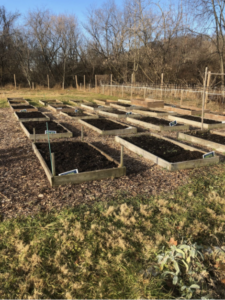
Image shows the raised beds section of Lower Hackett Farm which are used as community garden plots
There is an annual seed planting day where Easton Garden Works provides those who have signed up for a community garden plot with vegetable and flower seeds to choose from to plant within their personal garden plot. The gardeners also have the opportunity to bring their own seeds and grow whatever they want in their personal plot. While this is the main day the gardeners put seeds in their plots, it also offers a social setting for the gardens to gather and to meet each other to develop relationships.
Once the seeds are planted, it is up to the user of the plot to maintain their plot. Ms. Wilcha told us that some of the gardeners actively maintain their plots by harvesting their ripe vegetables, constantly watering and weeding their plot, while others begin to forget about their plot and let it grow out of control. Unfortunately, when members of the community do not tend to their plots they can get a bit messy. Figure 10 gives a nice illustration of how different plots are managed. The plots on the far left of the picture are neatly tended to while the ones in the middle are growing wildly out of control.
Fig. 10 : Photograph of Raised Beds
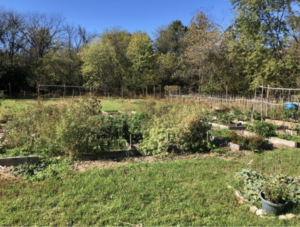
Image shows the difference management of the community garden plots Raised Beds when left to grow out of control
There are an additional five field plots which are similarly taken care of by community members; however, these people preferred to do their growing in the ground rather than in a raised bed. These plots are a bit larger, with dimensions of 11 feet by 8 feet.
In-Ground Beds Background
The other beds at Lower Hackett Farm are the in-ground beds. These beds are maintained by Ms. Wilcha and volunteers that come to Lower Hackett. These beds are the main area where vegetables, flowers and fruits are grown by Easton Garden Works. See Figure 3 on Page 8 for their current location within . There is currently 1,964 square feet of in-ground bed area at Hackett. While this may seem like a large plot for the in-ground beds, it is important to note that not all of this area is used for the in-ground beds. Since these beds are planted in rows, there are grass areas used to walk between beds that are not used for growing vegetables, fruits and flowers.
Figure 11 : In-ground Beds
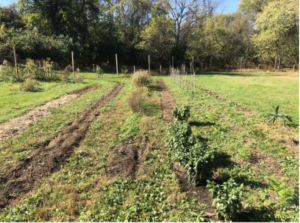
Image shows the currently six rows of in-ground beds at Hackett Farm
The crops that are grown in these in-ground beds are picked fresh from Hackett Farm and brought to the wash station on site. Once the vegetables have been washed and dried, they are stored in Hackett’s walkin Coolbot until they are taken off to the Lafayette College run West Ward Veggie Stand. The West Ward Veggie Stand, a weekly pop up, donation only, farmers market put on at the 10th and Pine Street Community Garden during the summer months. The aforementioned Vegetables in the Community (VIC) program oversees these operations in hope to build community strength in the West Ward of Easton through the production and distribution of fresh, locally grown produce. By expanding and rearranging the current layout of the farm, there could be a great crop yield grown at Hackett leading to more vegetables for the community. This rearrangement will allow for Ms. Wilcha to more easily manage the Hackett Farm and help grow a greater sense of community through agriculture.
Ryegrass Driveway
One of the main concerns that Ms. Wilcha addressed to our group was the lack of maneuverability throughout the farm for her truck. She needs this to be improved to be able to bring loads of mulch, soil, compost or other things into different areas of the farm. Since the farm previously had a lack of original planning due to the quick turnover to Easton Garden Works, we are proposing a solution that will be able to significantly improve the current layout of the farm and make Ms. Wilcha’s job is easier. The first step in the rearrangement of Lower Hackett Farm is to create a grass driveway that spans the length of the farm. This path will greatly help Ms. Wilcha reach all areas of the farm with her truck.
Fig 12. Proposed Ryegrass Path
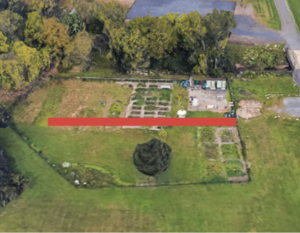
The image shows an aerial view of Hackett Farm and where the Ryegrass Driveway will be located
A simple perennial ryegrass path will span from the 9 foot wide entrance gate for 150 feet in length totaling 1,350 square feet of ryegrass. Ms. Wilcha preferred a grass path over gravel because she wanted to limit the amount of rocks and impervious surface coverage within Hackett Farm. Having a grass path will help with stormwater collection and be significantly more cost effective than stone. Choosing a grass path over gravel also eliminated the need for further grading of the site to accommodate a more advanced engineered path. Ryegrass is a traffic tolerant grass and germinates quickly. This ensures that the creation of the path will be easy to make and be durable for daily use.
Nature’s Seed is a website that offers gardening and planting tips. They give a deep dive into how perennial ryegrass should be grown and why it is a good choice for heavily trafficked grass areas.. For proper establishment of the rye grass seed, there are two chances to plant: Once in the late summer (or early fall) and once again in the early spring. The path for which is the seedbed needs to be prepared at least six months before the expected planting date to make sure any soil amendments you add have time to react. Amendments should have organic fertilizer high in nitrogen content. Ryegrass flourishes in a soil pH of 5.5 to 7.5, though it will tolerate soils with a pH range between 4.5, up to 8.4. Like many other perennial cool-season grasses, the seeds of ryegrass go through several growing points of initiation and induction. Seeds use the time below-ground, for example, during the months of September to early March to gather and cultivate energy. Seeds should be sown at about one-fourth to half-an-inch deep within the soil using standard lawn spreader or even a grain drill. If using a spreader, you’ll need to pack the soil to make sure there is adequate seed-to-soil contact. A grain drill, on the other hand, will accurately deposit seed into the soil’s surface.
In order for this path to be implemented, some of the current raised community garden beds need to be relocated because they are currently in the way of where the proposed path will be. Once these beds are moved, we estimate that a two person volunteer crew can complete the maintenance needed to lay the path in one day. We advise on renting a sod cutter with an 18” cutting blade from Home Depot for the day to remove the current layer of grass. Someone will operate the sod cut to make the nine foot wide pathway for the 150 feet through the middle of the farm. See Figure 12.
Once the path is developed, we recommend renting a self-propelled TA18HD aerator from Home Depot to aerate over the path. We recommend aeration because grass roots need air, water and nutrients to grow thick, deep and strong. When soil becomes compacted, even slightly, it inhibits the flow of the essentials that support thicker, healthier turf growth. A layer of compacted soil just 1/4 to 1/2 inches thick can make a significant difference in the health and beauty of your lawn. Aeration creates holes down into the soil to alleviate compaction so air, water and nutrients can reach grass roots (Harper).
Lastly, the grass seed needs to be poured. We recommend buying the 15,000 sq. ft. Turf Builder EdgeGuard DLX Broadcast Spreader for Seed, Fertilizer, and Ice Melt from Home Depot to spread the ryegrass seed. We estimated that the 25 pound bag of Pennington Annual Ryegrass Grass Seed will be enough seed for our path. Once the seeds are spread, wait a few weeks and the grass should germinate rather quickly. It is important to note that Ms. Wilcha must wait until the grass is fully germinated until the path experiences any type of vehicular traffic on it. Driving the truck over premature grass could cause this path to never reach its intended potential.
Moving Raised Beds
As shown below in Figure 13 , there is a large unused section of the farm directly behind the current location of the raised beds. In this space we propose moving the beds in the way of the path along with creating more raised beds to allow for more Easton community members to get involved with Hackett Farm.
Figure 13: Movement of Raised Beds
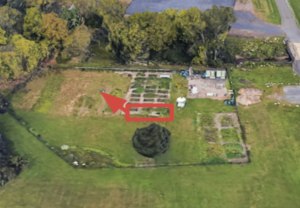
The raised beds in the way of the path will be relocated. Additional raised beds will be created in the back right corner of the farm.
The expansions of the raised beds area will allow for more community members to have access to having a personal plot at Hackett Farm. This increase of community engagement directly correlates with Easton Garden Works mission: “giving residents the opportunity to maintain their own plot of green space and fostering a community of individuals interested in sustainability and making Easton a greener city.” We estimate that the Raised Beds area at Hackett Farm will expand to 4,300 square feet, a 45% increase in total space. In addition to relocating six beds due to the creation of the path, we calculate that there will be enough area for an additional 15 raised beds. the spacing between the beds will remain the same as it currently is and the plots will continue to be directly maintained by community members.
In order to build these beds and expand the raised beds area, mulch, lumber and soil need to be purchased. The area that the raised beds will be located on will need to be mulched. Palmer Nursery, a local mulch supplier, offers different options of mulch sold by the cubic yard. They offer 100% pure bark mulch at a price of $36.50 per cubic yard. Bark mulches add aesthetic appeal and also help improve the health of a garden. This type of mulch is long-lasting and less likely to blow away. Bark offers an excellent form of weed control and is readily available and over time, it can help reduce soil compaction. Bark mulch decomposes more slowly than wood chips, so you don’t have to replenish it as frequently. There are few disadvantages to this type of mulch and is recommended by our group. If we estimate a two inch thick base layer of mulch covering the 43 foot by 100 foot proposed raised bed space, 26.54 cubic yards of mulch will be needed. In this case, we recommend purchasing 27 cubic yards of mulch to ensure that their is a sufficient amount.
We will plan on reusing the lumber for all of the existing raised beds so we will only need to buy 2 in by 8 in by 16 feet pressure treated lumber for the new raised beds we will be constructing. Since the dimensions of the raised beds are 4 feet by 8 feet, each bed requires 24 feet of lumber. In order to have enough lumber for the 15 new raised beds there will need to be 360 feet of lumber purchased. Since Home Depot sells 2 in by 8 in pressure treated lumber as 16 feet long, at least 23 of these boards will need to be bought and the cut to be the dimensions of the beds.
Lastly, soil needs to be put into the beds for the community members to build their own personal garden plots. We are assuming that the existing plots will keep their same soil. The only soil that will be needed is for the 6 moved garden plots and 15 new garden plots. With bed dimensions of 4 feet by 8 feet by 8 inches, one bed can hold 0.79 cubic yards of soil. We recommend buying 17 cubic yards of soil to fill the 21 beds that need soil. Palmer Nursery also sells soil and they recommend aged mushroom and compost soil for gardens. They charge $34.50 per cubic yard of soil.
Economic Estimation
The cost estimate of rearranging the beds of Hackett Farm is two fold. One main cost is the creation of the ryegrass path and the other is construction of new raised beds. While these costs are much larger compared to the other project, they will be upfront and long lasting. These costs will drastically improve how the farm operates and the improve the day to day
Table 3. Ryegrass Path Pricing
| Hardware | Price (USD) |
| 1 Day Sod Cutter Rental | $114.00 |
| 1 Day TA18HD Aerator Rental | $92.00 |
| 15,000 sq. ft. Turf Builder EdgeGuard DLX Broadcast Spreader for Seed, Fertilizer, and Ice Melt | $66.97 |
| 25 pound bag of Pennington Annual Ryegrass Grass Seed | $31.98 |
| Total Cost = $304.95 |
All costs directly from Home Depot’s Website
Table 4. Construction of New Beds Pricing
| Hardware | Quantity | Individual Price | Price (USD) |
| Cubic Yards of Pure Bark Mulch | 27 | $36.50 | $985.50 |
| 2inx8inx16ft Pressure Treated Lumber | 23 | $24.88 | $572.24 |
| Cubic Yards of Soil | 17 | $34.50 | $586.50 |
| Total Cost= $2,144.24 |
All costs directly from Home Depot’s and Palmer Nursery’s Website
Click here to go to our Irrigation Breakdown.